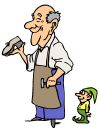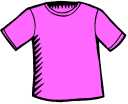
After hearing the story, "The Shoemaker and the Elves," the students will find the capital resources of the shoemaker’s business.
Introduction
A long time ago some people worked as shoemakers (also called cobblers). A shoemaker made shoes. Each shoe was made one at a time to fit someone's foot. How do you think that is different from the way shoes are made today? (Explain that today shoes are mass produced on an assembly line.) In any business, people must have certain tools and equipment that help them do their job. We are going to learn about these CAPITAL RESOURCES in our lesson, using the shoemaking business as an example. The students will match different capital resources used to produce a product to the business that uses that resource or the end product.
shoes. Each shoe was made one at a time to fit someone's foot. How do you think that is different from the way shoes are made today? (Explain that today shoes are mass produced on an assembly line.) In any business, people must have certain tools and equipment that help them do their job. We are going to learn about these CAPITAL RESOURCES in our lesson, using the shoemaking business as an example. The students will match different capital resources used to produce a product to the business that uses that resource or the end product.
Learning Objectives
- Identify examples of capital resources used in the production of a given product.
Resource List
-
The Shoemaker and the Elves: Click on the link to hear the story of "The Shoemaker and the Elves." Notice what capital resources the shoemaker leaves for the elves to produce shoes each night.
www.schoolexpress.com/storytime/shoemaker.html
-
Space Shoe: This website provides students with an example of a shoemaker who still makes shoes one at a time for a specific costumer.
www.spaceshoe.com/
-
Colonial Williamsburg: Use this site to provide students with information and shoemakers and the materials they use.
https://www.history.org/almanack/life/trades/tradesho.cfm
-
Drag and Drop Activity: This activity has the students demonstrate their understanding of capital resources.
Matching Activity
Process
-
Tell the students that Capital Resources are special tools, materials, equipment,
 machines, and buildings that are used to make other goods and services.
machines, and buildings that are used to make other goods and services.
- Ask students; If you made a valentine for your mom, what would you use? [paper, scissors, glue, markers, pens, etc.] Those are all CAPITAL RESOURCES, or items you would use in order to produce the valentine. Businesses use CAPITAL RESOURCES in order to produce what they sell.

-
Ask the students to think about how people make t-shirts. What capital resources are used in making t-shirts? [Fabric, thread, sewing machines, the building where the people worked, scissors, pins, etc.]
-
Consider shoes in the same way. What did the business that made your shoes use? [Possibly leather, thread, glue, some sort of dye, rubber, machines, etc.]
- Tell the students about cobblers. A long time ago cobblers, or shoemakers, made shoes one at a time by hand. Each shoe was made especially for the foot of the person who wanted the shoe. What sort of tools and materials did the shoemaker need to make the shoes? [leather, hammers, thread, work table, etc.]

- Read the story of "The Shoemaker and the Elves " and see what CAPITAL RESOURCES the shoemaker leaves for the elves so that the elves could produce a pair of shoes.
Visit the Space Shoe website and find out how one business still makes shoes one at a time for each person.
https://www.history.org/almanack/life/trades/tradesho.cfm , a shoemaker's complete tool kit included relatively few items and could be purchased for about the same price as a common pair of shoes.
There are three productive resources used in the production of goods and services. They are natural, human, and capital resources. We are ignoring the natural and human resources in this lesson. The use of elves in the production of shoes may not be considered "human" so it was decided that only capital resources would be identified. If the teacher would like to proceed with the human element (the shoemaker) and the land on which the shop sits (natural), then that would be a natural progression of this lesson.
Conclusion
All businesses use tools and materials to produce goods and services. These CAPITAL RESOURCES are important. What would school be like without books, pencils, pens, paper, scissors, glue, markers, crayons, desks, chairs, a school building, or any other supplies? We need these goods to teach students.
Assessment
Have the students show their understanding of capital resources by doing a matching activity. This activity will match certain capital resources with the business that uses the resource to produce goods and services or the end product.

